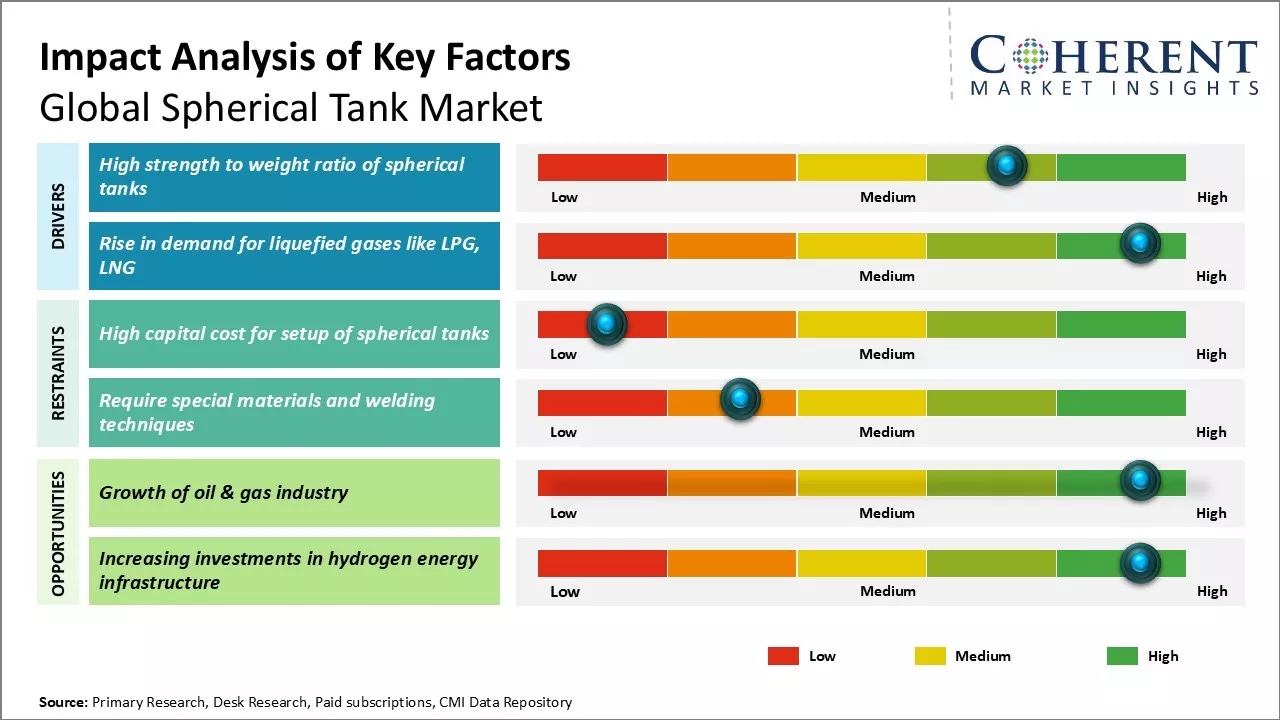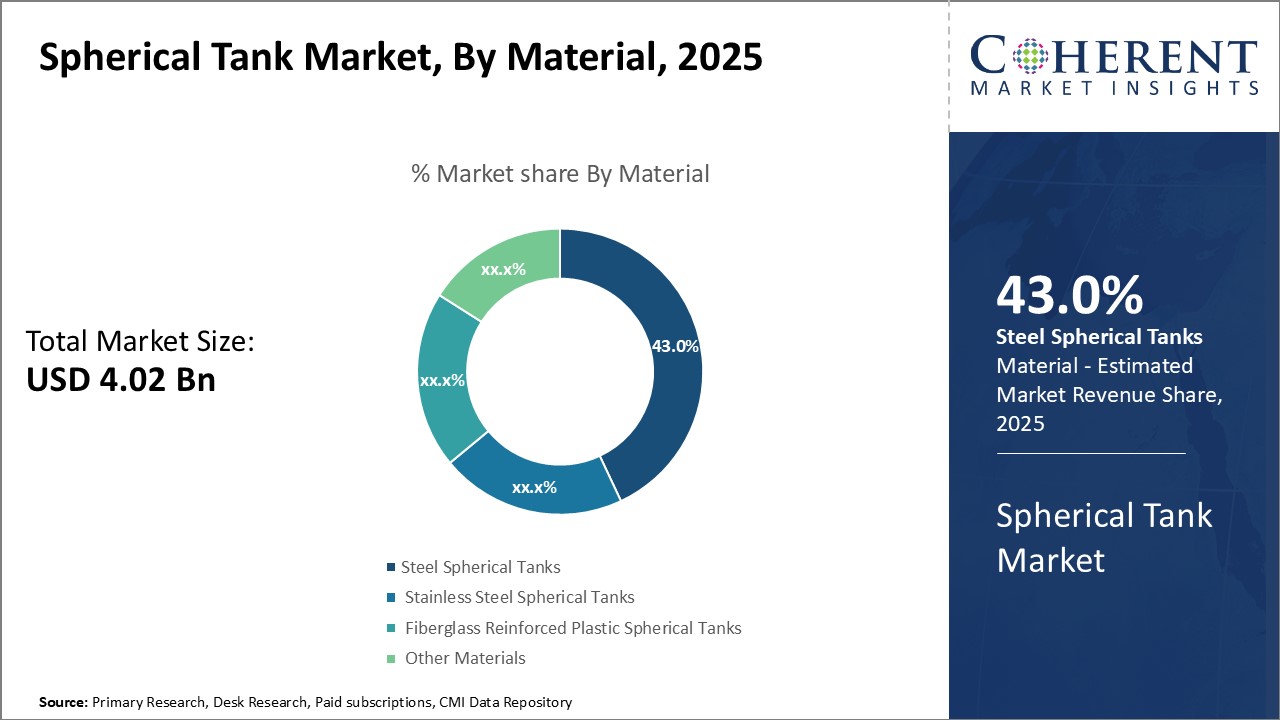Spherical Tank Market Size and Trends
Global spherical tank market is estimated to be valued at US$ 4.02 Bn in 2025 and is expected to reach US$ 5.44 Bn by 2032, exhibiting a compound annual growth rate (CAGR) of 4.4% from 2025 to 2032.

Discover market dynamics shaping the industry: Download Free Sample
The market growth is primarily driven by growing demand from sectors like chemicals and petrochemicals, food and beverage and power generation industries where spherical tanks are ideal for bulk storage of liquids and granular materials.
High strength to weight ratio of spherical tanks
Spherical tanks offer significant advantages over conventional cylindrical tanks due to their unique shape. The hemispherical shape of spherical tanks provides greater strength as compared to cylindrical tanks of equivalent size. Moreover, a spherical tank can withstand both internal vacuum and external pressure uniformly due to its design. This high strength to weight ratio allows spherical tanks to use lighter materials like aluminum and stainless steel for their construction. Steel tanks need to be significantly thicker to match this strength.
Lighter construction not only reduces the raw material costs but also the transportation costs of spherical tanks. As spherical tanks can be made with thinner metal, there will be significant reduction in metal quantity. This directly cuts down on shipping expenses since more tanks can be transported in the same vehicle or container. Furthermore, installation of spherical tanks is easier as their lighter weight requires less robust supporting structures. As these are less prone to corrosion due to their seamless designs, maintenance of spherical tanks over their lifespan is also cost-effective.
Market Concentration and Competitive Landscape

Get actionable strategies to beat competition: Download Free Sample
Rise in demand for liquefied gases like LPG, LNG
With rapid industrialization and growing energy demand, there has been increase in production and transportation of liquefied petroleum gas and natural gas. LPG is extensively used for household cooking and automobile fuel while LNG is used in power generation and industrial processes. Being in liquid form allows these gases to be shipped over long distances via special tankers economically. This has boosted investments in creating import and export infrastructure as well as storage terminal networks across major economies.
Spherical tanks have emerged as the primary storage vessels for LPG and LNG due to their compatibility with the cryogenic temperatures of these liquefied gases. Their spherical shape provides greater strength at thin walls to withstand high inner pressures of pressurized liquefied containment. Roll-on roll-off design of spherical tanks also eases loading-unloading operations. Thus, new as well as replacement LPG and LNG storage projects are increasingly adopting spherical tanks. With energy demands projected to grow substantially in developing Asian markets and many new LNG receiving terminals under works, there has been huge demand for spherical tanks.
Key Takeaways from Analyst:
Global spherical tank market is expected to witness steady growth.. North America currently dominates the market, owing to increasing demand from the chemical and petrochemical industries in the region. However, Asia Pacific is likely to emerge as fastest growing market due to rising production and consumption of chemicals in countries like China and India.
The transportation of liquid products boosts demand for spherical tanks. As companies transport chemicals and petroleum over long distances, there will be huge demand for spherical tanks. Furthermore, their ability to withstand high pressures and corrosive environments provides advantages over conventional tank designs. Adoption in liquefied natural gas sector can further boost sales.
Fluctuating raw material costs can pose challenge for manufacturers. Mild steel continues to be the dominant material though demand is rising for high alloy and stainless steel variants to meet stringent quality needs. Consolidation trends in end-use industries also impacts demand dynamics at regional level. Lack of standardized fabrication technologies can hamper the market growth.
Increasing focus on process optimization and safety in chemical plants can boost uptake. Furthermore, rising disposal income and industrialization in developing markets can present new avenues for market players. Research into composite materials can also expand spherical tank applications in the near future.
Market Challenges: High capital cost for setup of spherical tanks
Setting up spherical tanks requires high capital investment as these tanks are significantly more expensive than conventional tanks due to their complex shapes and robust engineering and manufacturing requirements. The production of spherical tanks involves advanced techniques like heavy welding, multi-axial rotations during fabrication, and stringent quality norms to ensure shape retention and withstanding high operating pressures. Transportation and installation of these large tanks also require specialized heavy lifting equipment, which further increases project costs. With stringent budgets, the high setup costs of spherical tanks pose significant challenges for end users especially in price-sensitive markets, which negatively impacts the demand for spherical tanks. Unless manufacturers find ways to optimize costs through innovative manufacturing processes and modular construction techniques, the high capital expenditure will continue to limit the growth potential of the global spherical tank market.
Market Opportunities: Growth of oil & gas industry
Global spherical tank market is expected to witness significant growth opportunities due to rising demand from the expanding oil and gas industry. Spherical tanks are increasingly being utilized by oil and gas companies for aboveground storage of liquified petroleum gases (LPG) like propane and butane. These are also used for large-volume storage of petrochemicals and crude/processed oil due to their efficient utilization of space. With growing energy needs worldwide, there has been increase in investments in oil and gas exploration and production activities. The expansion of refining capacities and the focus on developing shale reserves by major economies can boost the growth of the downstream petrochemical industry. This rising requirement for storage from these industries can boost demand for large spherical tanks during the forecast period. Manufacturers can leverage this opportunity by developing cost-effective and customized solutions to target the oil & gas segment.

Discover high revenue pocket segments and roadmap to it: Download Free Sample
By Material- Affordability and Durability Boosts Dominance of Steel Spherical Tanks
In terms of material, steel spherical tanks segment is estimated to contribute the highest market share of 43.0% in 2025, due to their affordability and durability. Steel is a highly cost-effective material for large tanks that can be used to store chemicals, petroleum products, and other industrial liquids. The material offers strength and resistance to corrosion at a lower price point than alternatives. This affordability allows steel tanks to be widely implemented across price-sensitive industries like oil and gas extraction, petrochemical manufacturing, and utilities.
Steel spherical tanks demonstrate remarkable durability suitable for demanding industrial applications. Their cylindrical and spherical segments withstand high inner pressures often encountered when containing liquids and gases. Advanced steel alloys also combat degradation from exposure to weather environments and chemical reactions with stored contents. Some tanks are engineered to operate for 30-50 years with minimum maintenance required. The longevity of steel tanks helps reduce long-term capital costs for businesses through infrequent replacement needs.
The established global steel production industry can drive the segment growth. Abundant steel manufacturing ensures consistent supply to meet the large production volumes demanded. Extensive production experience also helps steel tank makers to achieve stringent quality and safety standards. Mature supply chains reliably deliver steel components on schedule. The sophisticated steel sector economy of scale keeps material costs low.
By Capacity- Large Volume Needs Boosts Demand for 100 m3 to 500 m3 Capacity Tanks
By capacity, 100 m3 to 500 m3 segment is estimated to contribute the highest market share of 61.7% in 2025. This size range matches the volume necessities of many industrial liquid storage applications. Utilities maintaining fuel reserves, refineries holding petrochemical feedstocks, and chemical plants temporarily storing products commonly require tanks in this midpoint size bracket.
Larger capacity tanks above 500 m3 are costly for usage scenarios involving moderate throughput. Conversely, sub-100 m3 tanks often lack filling efficiency and may necessitate more numerous units for identical total volume needs. The 100 m3 to 500 m3 bracket achieves an optimal balance of liquid containment at competitive price points.
Facility layouts also factor into the popularity of this size class. Tanks in the lower hundreds of cubic meters fit conveniently into existing plant footprints. Their dimensions avoid major site reconfigurations that larger tanks could demand. Standard configurations and modular designs additionally speed installation to minimize disruptions. Thus, industries seeking practical tank solutions frequently incorporate these mid-sized spherical vessels rated 100 m3 to 500 m3.
By End-use Industry- Unique Storage Requirements Propel Oil & Gas Industry Leadership
By end-use industry, oil & gas segment is estimated to contribute the highest market share of 49.4% in 2025, due to its distinctive product handling demands. Upstream extraction and midstream transportation require versatile containment supporting varied hydrocarbon mixtures. Spherical tanks particularly accommodate this need through their UV resistance and ability to segregate immiscible liquids.
Likewise in refineries and petrochemical plants, precise processing depends on reliable short-term storage. Spherical tanks maintain segregation of multiple feedstocks and intermediates without risk of mixing. Their design inherently avoids dead zones that can trap unwanted residues. This purity supports consistent product yields.
Harsh working conditions further drive oil and gas sector’s preference for spherical tanks. Locations from oilfields to marine terminals subject tanks to extremes in temperature, vibration, and potential impact. The spherical segment architecture endows optimal strength to reliably withstand these stresses. Integrity protects against environmental contamination and accidental release risks. Recognizing these special handling prerequisites, oil and gas sector consistently leads early adoption and largest consumption of spherical tank technologies.
Regional Insights

Need a Different Region or Segment? Download Free Sample
North America has established itself as the dominant region in the global spherical tank market, with an estimated market share of 39.1% in 2025. The vast oil and gas industry in the U.S. and Canada has boosted demand for large capacity storage tanks. Major oil producing states like Texas, Alaska and manufacturing hubs have provided a fertile ground for spherical tank providers. With rich expertise available in fabrication and engineering services, many key players in this market are based in North America catering to both domestic as well as international clientele. Moreover, the presence of trade organizations promoting use of advanced materials and designs has continuously improved adoption of spherical tanks in the region.
Asia Pacific is expected to emerge as fastest growing market for spherical tanks. Countries like China, India and Indonesia are witnessing explosive growth in their petrochemical and energy sectors. This has necessitated setting up of new production, refining and storage facilities. The low manufacturing costs and availability of skilled labour in Asia makes it an attractive destination for global manufacturers to establish manufacturing plants. This boosts demand for spherical tanks. Government initiatives promoting self-reliance in energy production also support the local tank makers. Port infrastructure developments in countries like India have boosted storage terminal projects requiring large overhead spherical tanks. The export activity from Asia Pacific region catering to demand from Middle East and African markets is consistently rising as well.
Asia Pacific region presents immense opportunities for future growth. Established connections with overseas clientele and developing domestic supply chains provide an advantage to Asian manufacturers. With rising economic and industrialization trends, there will be need for secure storage solutions. Strong manufacturing capabilities combined with cost competitive nature makes Asia Pacific an inevitable hotspot for global giants to invest and expand their footprints in the future.
Market Report Scope
Spherical Tank Market Report Coverage
| Report Coverage | Details | ||
|---|---|---|---|
| Base Year: | 2024 | Market Size in 2025: | USD 4.02 Bn |
| Historical Data for: | 2020 To 2024 | Forecast Period: | 2025 To 2032 |
| Forecast Period 2025 to 2032 CAGR: | 4.4% | 2032 Value Projection: | USD 5.44 Bn |
| Geographies covered: |
|
||
| Segments covered: |
|
||
| Companies covered: |
Chart Industries, Linde Engineering, Air Products and Chemicals, Inc., Cryogenics, Groupe Charles André, Technip Energies, Toyo Engineering Corporation, McDermott International, Saipem, EagleBurgmann, Messer Group, SABIC, Worley, JFE Engineering Corporation, BASF |
||
| Growth Drivers: |
|
||
| Restraints & Challenges: |
|
||
Uncover macros and micros vetted on 75+ parameters: Get instant access to report
Spherical Tank Industry News
- In March 2024, CIMC Enric Holdings Limited and its subsidiaries announced the commencement of construction in Fuyang, Anhui, for China’s first domestic commercial liquid hydrogen spherical tank. This tank is designed and developed by CIMC Enric’s subsidiary, Zhangjiagang CIMC Sanctum Cryogenic Equipment Co., Ltd. ("CIMC Sanctum"). This milestone project represents a significant advancement in liquid hydrogen storage and transportation technology, establishing a strong foundation for the rapid growth of the hydrogen energy sector in China.
- In June 2022, Mitsubishi Shipbuilding, a division of Mitsubishi Heavy Industries (MHI), introduced a new spherical cargo tank system for liquefied CO2 (LCO2) carriers. This design, created by leveraging technologies developed for spherical tanks used in liquefied natural gas (LNG) carriers, received approval in principle (AiP) from the French classification society Bureau Veritas (BV) at Posidonia that year.
*Definition: Global Spherical Tank Market covers the manufacturing and sales of spherical or spheroid tanks globally. Spherical tanks, also known as spheroid or ball tanks, are pressure vessels shaped as a sphere or near-sphere used for storage of liquefied gases like LPG, LNG, ammonia, and others. These provide efficient utilization of space and offer maximum storage capacity for a given surface area. The global spherical tank market includes companies involved in the design, fabrication, financing and construction of spherical storage tanks across various industries.
Market Segmentation
- By Material Insights (Revenue, US$ Bn, 2020 - 2032)
-
- Steel Spherical Tanks
- Stainless Steel Spherical Tanks
- Fiberglass Reinforced Plastic (FRP) Spherical Tanks
- Other Materials (Concrete, Aluminum, etc.)
- By Capacity Insights (Revenue, US$ Bn, 2020 - 2032)
- 100 m³ to 500 m³
- Less than 100 m3
- 501 m³ to 1,000 m³
- Above 1,000 m³
- By End-use Industry Insights (Revenue, US$ Bn, 2020 - 2032)
- Oil & Gas
- Chemical & Petrochemical
- Water & Wastewater Treatment
- Power Generation
- Others (Food & Beverage, Pharmaceutical, etc.)
- By Regional Insights (Revenue, US$ Bn, 2020 - 2032)
- North America
- U.S.
- Canada
- Latin America
- Brazil
- Argentina
- Mexico
- Rest of Latin America
- Europe
- Germany
- U.K.
- Spain
- France
- Italy
- Russia
- Rest of Europe
- Asia Pacific
- China
- India
- Japan
- Australia
- South Korea
- ASEAN
- Rest of Asia Pacific
- Middle East
- GCC Countries
- Israel
- Rest of Middle East
- Africa
- South Africa
- North Africa
- Central Africa
- North America
- Key Players Insights
- Chart Industries
- Linde Engineering
- Air Products and Chemicals, Inc.
- Cryogenics
- Groupe Charles André
- Technip Energies
- Toyo Engineering Corporation
- McDermott International
- Saipem
- EagleBurgmann
- Messer Group
- SABIC
- Worley
- JFE Engineering Corporation
- BASF
Share
Share
About Author
Ramprasad Bhute is a Senior Research Consultant with over 6 years of experience in market research and business consulting. He manages consulting and market research projects centered on go-to-market strategy, opportunity analysis, competitive landscape, and market size estimation and forecasting. He also advises clients on identifying and targeting absolute opportunities to penetrate untapped markets.
Missing comfort of reading report in your local language? Find your preferred language :
Transform your Strategy with Exclusive Trending Reports :
Frequently Asked Questions
EXISTING CLIENTELE
Joining thousands of companies around the world committed to making the Excellent Business Solutions.
View All Our Clients
